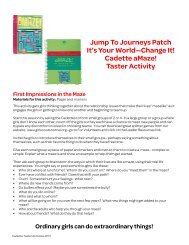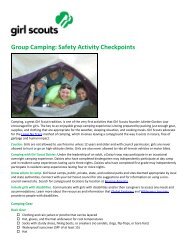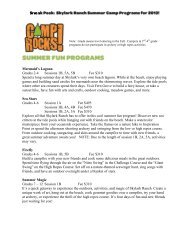Lovely Llamas Patch Program - Girl Scouts of Northern California
Lovely Llamas Patch Program - Girl Scouts of Northern California
Lovely Llamas Patch Program - Girl Scouts of Northern California
- No tags were found...
Create successful ePaper yourself
Turn your PDF publications into a flip-book with our unique Google optimized e-Paper software.
G I R L S C O U T S OF N O R T H E R N C A L I F O R N I AL O V E L Y L L A M AGS NORCAL COUNCIL’S OWN PATCH PROGRAMBROWNIES, JUNIORS, CADETTES, S ENIORS & A MBASSADORSTO INCREASE AWARENESS OF LLAMAS AS A BREEDAND TO ENCOURAGE INTERACTION WITH THE LLAMASAT GS NORCAL’S SKYLARK RANCH.Council Own UpdateThere are going to be some exciting changes to the Council’s Own badge and patch programs. GSUSA has shiftedtheir requirements for badges (per the <strong>Girl</strong> Guides to <strong>Girl</strong> Scouting) and is in the process <strong>of</strong> restructuring theCouncil’s Own program nationwide to reflect the new programming <strong>of</strong> <strong>Girl</strong> <strong>Scouts</strong>! We are very excited for thisnew development.As we get ready for the release <strong>of</strong> the new Council’s Own Guidelines from GSUSA, we are phasing out the existingCouncil’s Own patch and badge programs that reflected the old program. There are still some Council’s Ownpatches and badges available online…at a discount! The badge for this set <strong>of</strong> requirements is available inthe GSNorCal retail stores while supplies last http://store.girlscoutsnorcal.org/Councils-Own-Badges-c-222/PURPOSEThe purpose <strong>of</strong> <strong>Lovely</strong> Llama <strong>Patch</strong> <strong>Program</strong> is to provide the opportunity for girls to increase awareness <strong>of</strong> the breed andencourage interaction with the <strong>Llamas</strong> at Skylark Ranch <strong>Girl</strong> Scout Camp. Through participation in this patch programgirls will learn how to handle llamas, and how to be comfortable around them.SPECIAL THANKSSpecial thanks to Sarah Johanson and Tracey Weiss’s Gold Award projects for designing and updating the <strong>Lovely</strong> <strong>Llamas</strong><strong>Patch</strong> <strong>Program</strong>, so that all girls can learn about our <strong>Llamas</strong> at Skylark Ranch and increase their understanding <strong>of</strong> theseunique animals.PLEASE NOTEA Council representative must be present if the llamas at Skylark Ranch are being handled. For questions or to Contactthe Camp Ranger at (650) 879-1920 or Sari Van Otegham, Senior Director <strong>of</strong> Outdoor <strong>Program</strong> at (408) 287-4170 ext. 257ORDER INFORMATIONTo order the <strong>Lovely</strong> Llama <strong>Patch</strong> <strong>Program</strong>, please visit www.girlscoutsnorcal.org and purchase the items online. Pleasenote that shipping and handling will be added to all online orders.Members <strong>of</strong> <strong>Girl</strong> <strong>Scouts</strong> <strong>of</strong> <strong>Northern</strong> <strong>California</strong> will not be charged for shipping and handling if they use the GS NorCalCouncil’s Own Order Form and have badges shipped to the closest GS NorCal store in their area for members to pick up.O R D E R P A T C H E S O N L I N E AT W W W . G I R L S C O U T S N O R C A L . O R GF OR F U R T H E R I N F O R M A T I O N ON P A T C H P R O G R A M S C O N T A C T P A T C H E S @ G I R L S C O U T S N O R C A L . O R G1
L L A M A P A T C H R E Q U I R E M E N T S F O R B R O W N I E G I R L S C O U T SComplete 4 <strong>of</strong> the following activities including the ones that are starred (). Use the companionresource binder, the internet or your library to help you complete this program. All levels should share theknowledge they learn with another group1. Learn where <strong>Llamas</strong> are raised, where they originated and what other animals are part <strong>of</strong> their family. 2. Visit a local farm or zoo, wildlife park, or Skylark Ranch to observe the llama and other members <strong>of</strong> it’sfamily. Watch how the llamas interact with each other and how they act toward unfamiliar people oranimals. Then talk or write about what you learned.3. Discover how llamas are used today.4. Research how much it costs to care for a llama. Animal care includes food, health care, transportation,pens and shelter. Find out how much a llama costs and if there are any special regulations about having one.5. Find out what llamas eat. What foods are good or bad to feed them? What effects could the type <strong>of</strong> foodhave on a llama?6. What are some <strong>of</strong> the behaviors that a llama exhibits? Can you tell when a llama is upset or happy? Howabout when it is ready to spit? What ear positions let you know their emotions?7. What is llama wool used for? What are some <strong>of</strong> the different types <strong>of</strong> wool that the animals produce?Learn how llamas are sheared and how their wool is stored and cared for. What types <strong>of</strong> items do you havethat are made from wool?8. Compare sheep and llama wool. How are they different? What is the difference in how the wool isremoved and what it is used for.9. Talk to a veterinarian about the common health problems for llamas and the precautions that can be taketo prevent them.O R D E R P A T C H E S O N L I N E AT W W W . G I R L S C O U T S N O R C A L . O R GF OR F U R T H E R I N F O R M A T I O N ON P A T C H P R O G R A M S C O N T A C T P A T C H E S @ G I R L S C O U T S N O R C A L . O R G2
L L A M A P A T C H R E Q U I R E M E N T S F O R J U N I O R G I R L S C O U T SComplete at least 6 <strong>of</strong> the following activities including the ones that are starred (). Use thecompanion resource binder, the internet or your library to help you complete this program. All levels shouldshare the knowledge they learn with another group 1. Learn where <strong>Llamas</strong> are raised, where they originated and what other animals are part <strong>of</strong> their family. 2. Visit a local farm or zoo, wildlife park, or Skylark Ranch to observe the llama and other members <strong>of</strong> it’sfamily. Watch how the llamas interact with each other and how they act toward unfamiliar people oranimals. Then talk or write about what you learned.3. Discover how llamas are used today compared to the role that they played in their traditional setting.4. Research how much it costs to care for a llama. Animal care includes food, health care, transportation,pens and shelter. Find out how much a llama costs and if there are any special regulations about having one.5. Find out what llamas eat. What foods are good or bad to feed them? What effects could the type <strong>of</strong> foodhave on a llama?6. What are some <strong>of</strong> the behaviors that a llama exhibits? Can you tell when a llama is upset or happy? Howabout when it is ready to spit? What ear positions let you know their emotions?7. What is llama wool used for? What are some <strong>of</strong> the different types <strong>of</strong> wool that the animals produce?Learn how llamas are sheared and how their wool is stored and cared for. What types <strong>of</strong> items do you havethat are made from wool?8. Compare sheep and llama wool. How are they different? What is the difference in how the wool isremoved and what it is used for.9. Learn about the different parts <strong>of</strong> a llama pack and how to fit it to the llama. Find out how much a llamacan carry and try loading a pack.10. Talk to a veterinarian about the common health problems for llamas and the precautions that can be taketo prevent them.O R D E R P A T C H E S O N L I N E AT W W W . G I R L S C O U T S N O R C A L . O R GF OR F U R T H E R I N F O R M A T I O N ON P A T C H P R O G R A M S C O N T A C T P A T C H E S @ G I R L S C O U T S N O R C A L . O R G3
L L A M A P A T C H R E Q U I R E M E N T S F O R C A D E T T E S , S E N I O R S& A M B A S S A D O R SComplete at least 6 <strong>of</strong> the following activities including the ones that are starred (). Use the companionresource binder, the internet or your library to help you complete this program. All levels should share theknowledge they learn with another group 1. Learn where <strong>Llamas</strong> are raised, where they originated and what other animals are part <strong>of</strong> their family. 2. Visit a local farm or zoo, wildlife park, or Skylark Ranch to observe the llama and other members <strong>of</strong> it’sfamily. Watch how the llamas interact with each other and how they act toward unfamiliar people oranimals. Then talk or write about what you learned.3. Discover how llamas are used today compared to the role that they played in their traditional setting.4. Research how much it costs to care for a llama. Animal care includes food, health care, transportation,pens and shelter. Find out how much a llama costs and if there are any special regulations about having one.5. Find out what llamas eat. What foods are good or bad to feed them? What effects could the type <strong>of</strong> foodhave on a llama?6. Learn how to halter and walk a llama in an enclosed area and show that you are in command at all times.7. What are some <strong>of</strong> the behaviors that a llama exhibits? Can you tell when a llama is upset or happy? Howabout when it is ready to spit? What ear positions let you know their emotions?8. What is llama wool used for? What are some <strong>of</strong> the different types <strong>of</strong> wool that the animals produce?Learn how llamas are sheared and how their wool is stored and cared for. What types <strong>of</strong> items do you havethat are made from wool?9. Compare sheep and llama wool. How are they different? What is the difference in how the wool isremoved and what it is used for.10. Learn about the different parts <strong>of</strong> a llama pack and how to fit it to the llama. Find out how much a llamacan carry and try loading a pack.11. Take the llamas out for a day hike. Set a destination and bring the llamas with you. Pre-plan how tocontrol the llamas during situations that may arise while out hiking on a trail. Note: A CouncilRepresentative must be present to handle the llamas at Skylark Ranch <strong>Girl</strong> Scout Camp. See pg. 1 forfurther details.12. Talk to a veterinarian about the common health problems for llamas and the precautions that can be taketo prevent them.O R D E R P A T C H E S O N L I N E AT W W W . G I R L S C O U T S N O R C A L . O R GF OR F U R T H E R I N F O R M A T I O N ON P A T C H P R O G R A M S C O N T A C T P A T C H E S @ G I R L S C O U T S N O R C A L . O R G4
L L A M A L O R EWelcome to the fascinating world <strong>of</strong> llamas! Anyone interested in learning more about llamas, or trying toearn the “<strong>Lovely</strong> Llama” patch, will see that llamas are delightful animals with unique character. Use thisguide in addition to the Llama Resource Binder (located at the Council <strong>of</strong>fice or Skylark Ranch <strong>Girl</strong> ScoutCamp) to fulfill patch program requirements or simply learn more about these animals and the care andattention that they need.HISTORYThe llama is a member <strong>of</strong> the camelid family, and is part <strong>of</strong> the Lama genus. This helps us refer to a particularspecies. <strong>Llamas</strong> originally came from Asia and Africa. Approximately 10-12,000 years ago they migrated toSouth America and have originated from there ever since. The llama is known as one <strong>of</strong> the oldestdomesticated animals in the world. There are four native members <strong>of</strong> this family that we know <strong>of</strong> today. TheLlama, a domesticated beast located throughout the world; the Alpaca, a llama selectively bred for it’s fine,colorful wool; the Guanaco, the free ranging and well known herbivore that dwells in the arid land <strong>of</strong> SouthAmerica; and the Vicuna, a fine fleeced llama that lives in the central high Andean Mountains.CHARACTERISTICSThe first view <strong>of</strong> a herd <strong>of</strong> llamas can be a completely breathtaking experience. All llamas have a strikingaristocratic beauty and graceful posture. They are herd animals, normally with one male to each herd <strong>of</strong>females. They are friendly toward each other and humans. The wool on all llamas can vary greatly in colorand markings. Colors range from white, black, different shades <strong>of</strong> gray, red, brown, and roan, with marking <strong>of</strong>solid and spotted patterns.The llama is a quick learner that can be trained easily with a few repetitions. They have a keen sense <strong>of</strong> theirsurroundings and are able to read your body movements. For example, when you are relaxed the llama is moreapt to relax and feel comfortable around you. Quick sudden movements can put a llama on edge and causethem to be anxious. <strong>Llamas</strong> have very good hearing. When on a trail llamas may be able to hear approachinghikers before they are even in sight. The llama is a sure footed and balanced animal that is sturdy on anyterrain. Male llamas have fighting teeth that must be removed for safety reasons so not to cause injury to anyother llama or human. The fighting teeth are normally removed when the llama reaches two years <strong>of</strong> age. Likecattle and sheep, llamas are multi-stomached ruminants that chew their cud. The average llama weighsbetween 280-350 pounds and is fully grown by their fourth yearSHELTERThe preparations for housing a llama are simple but necessary for proper care <strong>of</strong> the llama. What constitutesadequate and safe fencing for a llama can vary. On average the fence needs to be 4.5 feet high. Some <strong>of</strong> thetypes <strong>of</strong> fencing available are v-mesh, no-climb, and chain link fence. Barbed wire isn’t recommended and canend up hurting the llama. Surrounding the top and bottom <strong>of</strong> the fences with electric wire can be useful forrestraint and for keeping out predators. A three sided shelter is necessary. It can be used as a catch area,5
training, grooming, and vaccinations, as well as helping to protect the llama from the elements. Easily reachedfeeding facilities should be designed so that food and water are always available and kept clean.CARE AND FEEDINGIf you are familiar with caring for any type <strong>of</strong> domestic livestock, you will find that caring for a llama isrelatively easy. A llama has a three compartment stomach. Although it has many <strong>of</strong> the same functions, it isanatomically different from other livestock such as cattle, sheep, and goats. <strong>Llamas</strong> need to eat about 2-4% <strong>of</strong>their body weight in a day. The basic nutrient requirements are proteins, fats, and carbohydrates. <strong>Llamas</strong> arehighly adaptable animals and can live in many different climates. About 91% <strong>of</strong> their food is dry matter: oathay, pay hay, brome, timothy, alfalfa hay, and orchard grass. Hay is <strong>of</strong>ten fed to llamas because <strong>of</strong> it’s highprotein content and it can keep for long periods <strong>of</strong> time. <strong>Llamas</strong> have a relatively low protein requirement, butit is essential to their diet. Working or nursing llamas need to be fed higher quantities <strong>of</strong> proteins to keepthem healthy and strong. <strong>Llamas</strong> require less water than most domestic animals but there should be anunlimited fresh clean supply at all times. Grain mixes should not be given to llamas because it will causebloating and make other foods hard to digest.HERD MANAGEMENTTo care for a large heard <strong>of</strong> llamas or different types, it is important to know how to separate them to ensurethe safety <strong>of</strong> the animals. The main herd consists <strong>of</strong> the females and their young. An adult male can be keptwith the group if he will be used for breeding. Expectant mothers should be kept separate. After the baby isborn it should be kept in a separate pen with other llamas it’s own age so that they can be watched to keepthem healthy and safe. Juvenile llamas need to be kept separate also as they can be very aggressive. When anew llama is acquired, make sure that it is introduced to the herd slowly so that the other llamas will not feelthreatened and will be more prone to accept the newcomer to the herd.VALUE AND USESThe uses and value <strong>of</strong> having a llama has changed greatly over the years. Long ago, the natives <strong>of</strong> SouthAmerica used the llama to help them survive in the rough environment. From helping to carry water andsupplies, to supplying the wool to make the clothes and baskets necessary to stay warm and survive. Todaythey are used as pack animals, wool producers, and family pets. <strong>Llamas</strong> are by far the easiest to care for <strong>of</strong> anydomestic animal and easy to train. During the past 20 years, the value <strong>of</strong> a llama has increased. Today the cost<strong>of</strong> a llama can vary greatly, from a few hundred to a few thousand dollars.<strong>Llamas</strong> have two coats <strong>of</strong> fine, downy, s<strong>of</strong>t wool that can make beautiful garments and blankets. There aremany ways <strong>of</strong> removing the wool from a llama. Spring shearing is the most efficient way <strong>of</strong> removing the wool.Through this method one llama can provide 2-7 pounds <strong>of</strong> oil free fleece that can be used for weaving. Othermethods <strong>of</strong> wool removal include clipping and brushing, but both <strong>of</strong> these methods require great amounts <strong>of</strong>time and yield less wool.6
The llama has become known as a wonderful packing companion because <strong>of</strong> their great agility and calmdemeanor. Male llamas between three and four years <strong>of</strong> age are the prime packers. It takes work to conditiona llama and train him to use a pack and follow a lead. There are two main types <strong>of</strong> packs that can be used, s<strong>of</strong>tand hard frames. The frames consist <strong>of</strong> two pack bags, called panniers, a breast collar, and a rump strap usedto help keep the pack in place. <strong>Llamas</strong> can carry between 40-50 pounds including their pack saddle and cancover a 10 to 15 mile distance per day depending on how well graded the trails are. When hiking with a llamait is important to stop and take breaks so that the llama can rest and drink from a water supply. <strong>Llamas</strong> areable to be tied together to form a llama pack string allowing you to lead them all with a single lead rope.When setting up camp for the night it is important that the llamas be “picketed” or tied down within sight <strong>of</strong>camp and in a cool or damp area.<strong>Llamas</strong> make minimal impact on the land and are easy to clean up after. Due to the llama’s ho<strong>of</strong> structure theymay leave many marks on the land. <strong>Llamas</strong> need only a small area to graze in and because llamas havecompact excrement which they leave in a small pile. It makes clean up easy when you are ready to leave.Hopefully you have enjoyed learning about llamas and about all the wonderful benefits they provide to people!Check out the resources listed below and the Llama Resource Binder for more detailed information andadditional resources for your troops program!R E S O U R C E SB O O K SDewdney, AnnaGuarino, DeborahHurwitz, JohannaBarre, Colleen StanleyLaBonte, GailArnold, CarolineLlama Llama, Red PijamaIs Your Mama a Llama?Llama in the LibraryLove a LlamaThe LlamaLlamaW E B S I T E SRangemore Llama FarmYellow Wood <strong>Llamas</strong>LlamaWebLlamapediawww.llamas.co.nzwww.ywl.comwww.llamaweb.comwww.llamapaedia.comP L A C E S TO S EE L L A M A S IN T H E B AY A R E AHappy Hollow ZooSan Francisco Zoo – You can even adopt a Llama!Skylark Ranch <strong>Girl</strong> ScoutRainbow Ridge Llama Ranch, Petaluma www.rainbowridgellamaranch.com 707-769-7370Bonny Doon Alpacas, Santa Cruz www.bonnydoonalpacas.org 831-426-8649Waters Edge Alpacas, Fort Bragg www.watersedgealpacas.com 707-961-62507
















